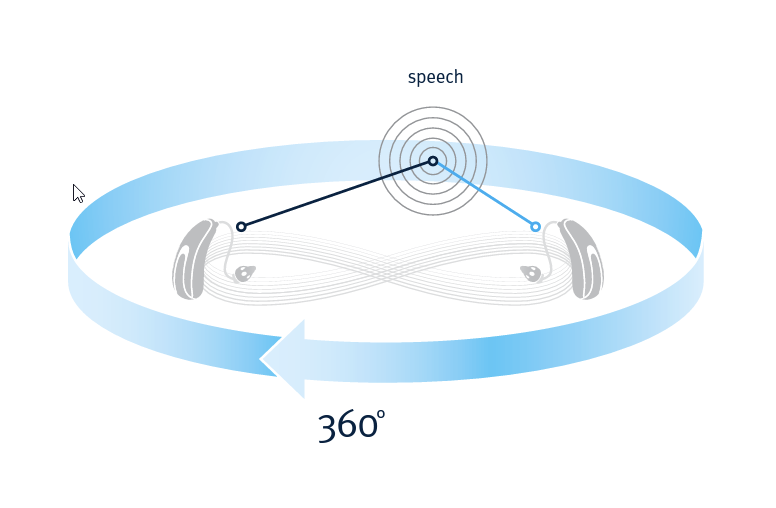Putting The Focus On Conversations

Difficulty understanding speech in noisy environments is the biggest complaint for those with hearing loss. In the real world, important speech doesn’t always come from in front of the listener. People often have conversations with those positioned at their side, even when their focus and attention needs to remain straight ahead. There can also be multiple people involved in a conversation and the target talker is not always positioned directly in front of the listener.
Bach introduced SoundScape Manager to help hearing aid wearers experience the best perception of speech coming from different directions in noisy environments. This premium-level technology uses the latest in algorithmic advances, including leveraging wireless technology to provide a variable directional beam based on the presence and location of a speech target. We have now taken this approach to the next level, using SpeechTarget 2 to help wearers focus on conversations in the toughest listening situations. SpeechTarget 2 functions within an overall strategy that supports conversations with unique types of background noise, rather than just a single class of speech in noise. It automatically engages the appropriate microphone strategy in each hearing instrument when the classification within the SoundTarget automatic program is one of the following:
1. Understanding conversations in a crowd
2. Understanding conversation in noise
These two conversation types represent the listening environments where wearers are likely to have the greatest amount of listening difficulty, especially if the person speaking is not directly facing the user.
Although the outcome that SpeechTarget 2 demonstrates is primarily a response in microphone strategy, the intelligence of the response is dependent upon the right and left hearing instruments wirelessly communicating with one another regarding the detection and location of the speech. This communication happens by wirelessly transferring data between hearing instruments when speech is detected. The system then responds based on the outcome – specifically, whether or not both hearing instruments agree on the location of the speech. When there is an agreement between the hearing instruments, the result is either a symmetric or asymmetric directional response based on where the dominant speech is coming from, making it more flexible for providing the wearer benefit.
Binaural Spatial Processing Is Key
SpeechTarget 2 knows where speech is coming from thanks to a combination of binaural spatial processing and wireless communication. SpeechTarget 2 uses speech detectors to identify when a dominant speaker is present from any angle, where less than 90 degrees indicates speech is in front and greater than 90 degrees indicates that speech is coming from the back.

It then uses detectors to look at the signal-to-noise ratio (SNR) difference between the hearing instruments. While an agreement on the presence of speech with equal SNR is consistent with a front or back location, a higher, more favorable SNR in one hearing instrument indicates speech is present on that side.
SpeechTarget 2 uses binaural spatial processing to determine the exact location of speech, whether it’s coming from the front, back, left or right. It then leverages advanced technologies to provide an intelligent response, automatically selecting a symmetric or asymmetric synchronized microphone strategy to ensure the best speech understanding in noisy environments. This is all done automatically when classification within Bach’s SoundScape automatic program is either the “Conversation in a crowd” or “Conversation in noise” listening environments. When speech is from the front the response is a symmetric maximum multi-band adaptive directionality. When speech is from the side the response is asymmetric, applying omnidirectional with Pinna Effect on the side targeting speech and adaptive directional on the side with noise. One of the great benefits of this asymmetric approach is that it can engage automatically when the conditions are deemed appropriate, without the risk of missing speech from the front. It locates the dominant speaker from any direction and maintains audibility without sacrificing environmental awareness or requiring the listener to stay in one place. When speech is from the back the response is symmetric, with both instruments in omnidirectional mode.

Hear speech from every direction
SpeechTarget2 is part of a sophisticated system that includes two other Bach signature features: SoundScape and Speech Finder. These three signature features automatically engage in the most challenging listening situations, working in harmony to help wearers focus on conversations like never before.
For more information on Bach Hearing Aids, visit BachHearing.com or call
1-800-416-2434 from 9:00 a.m. to 9:00 p.m. Eastern time, USA.
